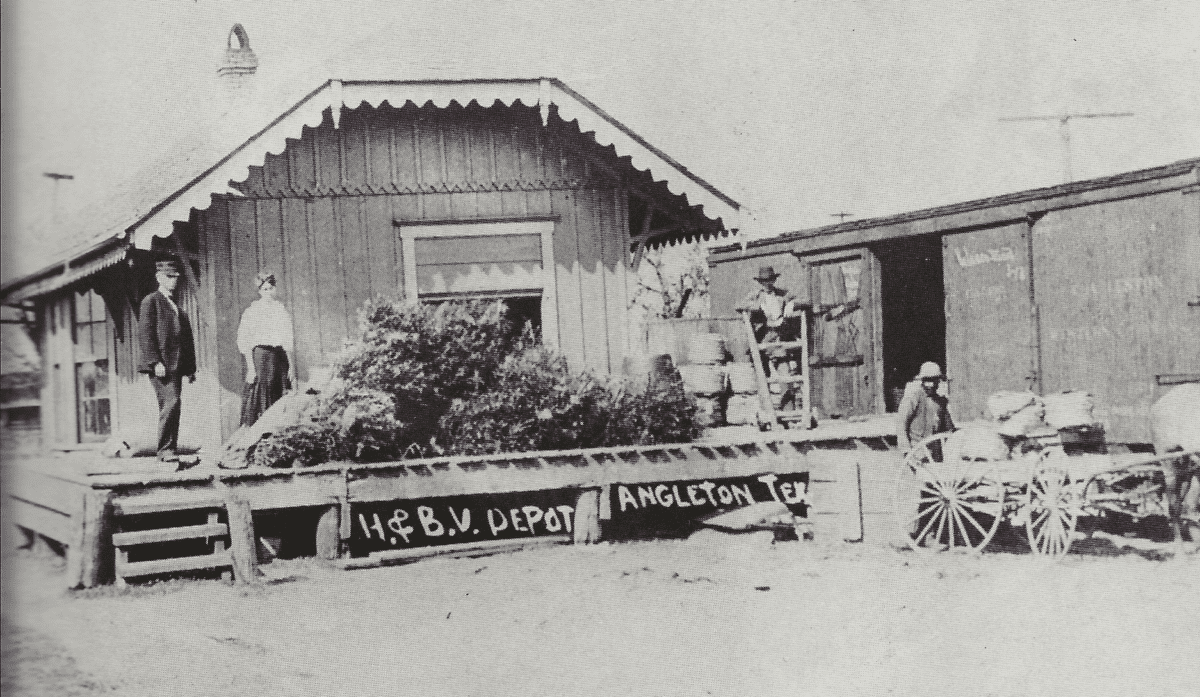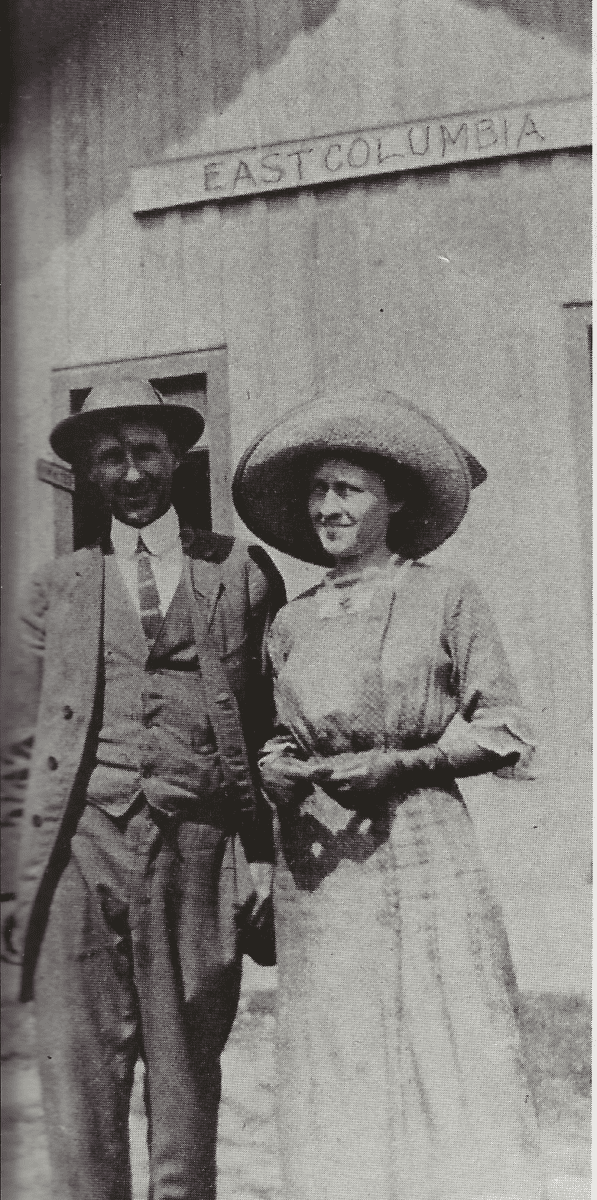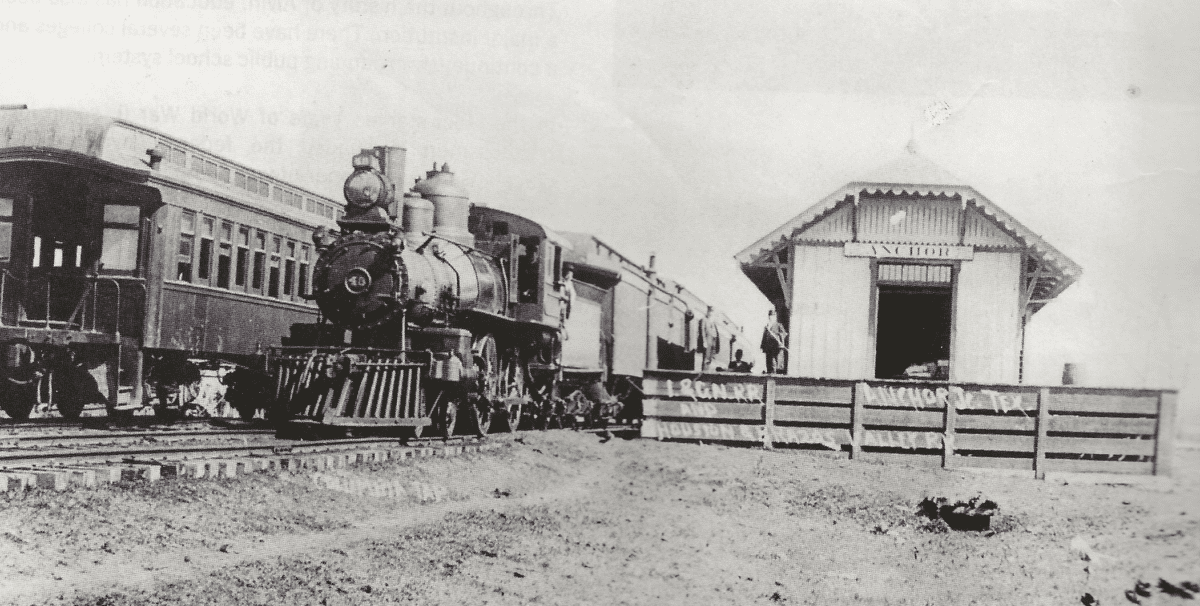![]()
By Tracy Gupton
West Columbia Rotary Club members were treated to an interesting history lesson surrounding the pre-automobile days of popular rail travel in southeast Texas this past Wednesday. Edward D. Pettitt II, president of the Rotary Club of Houston Skyline, was guest speaker at the West Columbia Civic Center at the September 13th Rotary Club luncheon.
Pettitt founded The Friends of Columbia Tap Rail-Trail in 2022 to hopefully create a better trail experience on the four- mile hike-and-bike trail in Houston’s Third Ward area. Ed Pettitt is a graduate research assistant at the Bullard Center for Environmental and Climate Justice at Texas Southern University in Houston.
He informed local Rotarians that railroad tracks were first laid in this area of Brazoria County in 1838 to transfer the sugar and cotton raised on local plantations to Houston and Galveston where it could be exported overseas to Europe. Pettitt said the Williams brothers had a large sugar plantation and James Fannin, who was executed at Goliad during Texas’s war for independence from Mexico in 1836, had a large plantation in what is known today as the Mims Community near Brazoria. The needs of these and many other plantation owners in Brazoria County to find better ways to get their agricultural products to the buyers outside this area in the earliest days of Texas as an independent republic and later as a state led to the laying of railroad track to serve this purpose.
Former West Columbia school teacher and historian James A. “Deacon” Creighton wrote in his 1975 book, “A Narrative History of Brazoria County” [Texas Press, published by Brazoria County Historical Commission], “Historically, Brazoria County must be considered the parent of the idea of rail transportation in Texas, since the very first mention of rail construction came in December, 1836, when Congress in session at Columbia granted a charter of incorporation to Branch T. Archer, James Collinsworth, James Pinckney Henderson, Thomas F. McKinney, and Stephen F. Austin. The corporation was named the Texas Rail Road, Navigation, and Banking Company, and its charter privilege was for ‘connecting the waters of the Rio Grande, by internal navigation and railroads, with the waters of the Sabine.’ It is probable that the company was more interested in banking than in transportation. At any rate, no effort was ever made toward rail construction, and the charter lapsed in 1838.”
Creighton wrote that, “Other proposals to construct railroads followed but likewise failed” in the early days of the Republic of Texas. “Among the early plans the most imaginative was one advanced by John Adriance (of East Columbia) and others – a plan which proposed to make Columbia the starting point of a track running all the way to the Pacific Coast via San Antonio. Abner Strobel tells of this plan and says that Horace Cone with others was sent to France to secure a multimillion dollar loan, which was obtained, but that the project collapsed when Cone died suddenly after his return to Texas from France.”
Strobel said in his memoirs of early Republic of Texas, “But for this mishap, the Southern Pacific would have been built from the Brazos River (in East Columbia) instead of from Harrisburg … and the main city of Texas … would have been the first capital of Texas – Columbia – instead of Houston. Such, however is destiny.”

Photo from “A Window to the Past: Brazoria County, Texas”
This train depot served the Houston and Brazos Valley Railroad in 1906. It stood on South Front Street in Angleton, the county seat of Brazoria County.
“A second effort which came to naught began on May 5, 1837, when George B. McKinstry, Patrick C. Jack, and George L. Hammeken petitioned Congress for a charter to build a railroad from Galveston Bay to the Brazos River,” Creighton writes. “Forty-one citizens of Brazoria signed the petition, and John Austin Wharton, senator from the Brazoria district, presented the petition. The charter was granted, and for five years the officers and stockholders held meetings, collected subscriptions, and even expended $3,000 and ‘much labor’ on the project, which changed from a project for a railroad to a project for a canal.”
According to George C. Werner, in a story he published in 1952 for the Texas State Historical Association, “The Houston Tap and Brazoria Railway Company was chartered on September 1, 1856, to run from Houston to Columbia (present day East Columbia on the Brazos River) in Brazoria County, with the right to also construct a line from Columbia into Wharton County. In 1859 the Houston Tap and Brazoria was extended to Sandy Point and in 1860 opened to East Columbia for a total of 50 miles of line.”
www.tshaonline.org/handbook/entries/houston-tap-and-brazoria-railway
Werner wrote that, “The railroad was built for a cash outlay of less than $13,000 per mile, as plantation owners were allowed to work out their stock subscriptions by having their field hands build much of the grade.”
Creighton, who was a teacher and coach in the early days of the West Columbia public school system in the 1920s, wrote, “On September 1, 1856, the planters united with the merchants of Houston and secured a charter for the Houston Tap and Brazoria Railway Company to build a railroad linking Houston and Columbia.” He said that the name “Houston Tap” came from the fact that the city of Houston had built a seven-mile track to Richmond to connect with the Buffalo Bayou, Brazos, and Colorado, tapping that road at Pierce Junction.

Photo from “A Window to the Past: Brazoria County, Texas”
Dr. Marcus Weems and his sister, Zuleika Weems, standing in front of the East Columbia depot
“The Houston people referred to this short line as the ‘Houston Tap’,” Creighton wrote. “Consequently, the Brazoria planters adopted the name ‘Houston Tap and Brazoria’ when, two years later, they bought out the Houston Tap road for $72,000. A loan of $300,000 was obtained from the State Special School Fund, and with this money plus a Brazoria County bond issue of $100,000, work began on the route from Pierce Junction to (East) Columbia, a distance of about 50 miles.”
Pettitt told local Rotarians this past Wednesday that slave labor was the primary source of workers who built the many miles of rail in this region of Texas in the 1800s. He said the “Triangular Trade” of enslaved people from Africa to perform the manual labor of laying the railroad track and work in the fields, the productive plantations of Southeast Texas, and the exporting of the cotton from Houston and Galveston to the textile mills in Europe made Houston a manufacturing hub.
“By 1900 Galveston was the largest cotton port in the world,” Pettitt said.
“The planters (of Brazoria County) contributed free labor and furnished material for ties and bridges,” Creighton wrote in his “Narrative History of Brazoria County” book. “Slave labor was used, and stock was largely paid for by labor and material furnished. The list of stockholders included almost every planter in Brazoria County, though the largest stockholder (150 shares) was Jonathan Dawson Waters of Brazoria and Fort Bend counties.”

Photo from “A Window to the Past: Brazoria County, Texas”
International and Great Northern (the Columbia Tap) depot in Anchor at the junction of three railroads, the only town in Brazoria County to be so situated. The International and Great Northern Railroad from Houston to Columbia was built through the Anchor area about 1852. Forty-one years later, the Houston and Brazos Valley Railroad crossed the original line and the spot was called “Chenango Junction.” A third line was added in 1908 to Sugar Land.
Called the “Sugar Road,” the railroad line served the prosperous plantation region of Brazoria County, wrote Werner in the TSHA article. “By the late 1860s the track had deteriorated to such a point that only infrequent service was attempted.”
Pettitt told local Rotarians in his slide presentation last Wednesday that the Civil War ended the use of slave labor and railroad companies began contracting the use of Texas inmates in a convict lease program with the state prison system. Pettitt said the state stopped leasing convicts for railroad labor in 1914.
Catherine Munson Foster, another deceased historian of Brazoria County like Creighton, reported that the Houston Tap and Brazoria Railway made its initial run from East Columbia (then known as Marion or “Bell’s Landing”) to Houston late in 1859. The Houston Tap and Brazoria Railway, colloquially referred to as the Columbia Tap, was listed as one of 10 railroads in operation in Texas in 1861 before the Civil War.
Creighton wrote in his book that “a group of Columbia boys with Bob Faickney as captain formed themselves into a company to share the excitement of the maiden trip” by train from East Columbia to Houston. “Joe Underwood, then about 14, never forgot that trip. The train was met in Houston by a gang of ‘city boys,’ who were apparently ready for action, and a ‘chunking’ battle ensued. The exchange of clods of dirt was hot and heavy, and things were touch and go for awhile. In the end the Columbia boys were victorious and succeeded in running the Houston boys off.”
“The railroad never made it across the (Brazos) river at Columbia,” Mrs. Foster wrote, adding that the planners had originally intended to extend it to Wharton County but the Civil War put a stop to the railroad tracks construction.
Creighton wrote that “the late Mrs. Pearl Rucks, of Angleton, quoted her mother, Mrs. James Jamison, as saying that occasionally she with five or so of her children would make a trip to Houston on the train, catching it near their home in the Oyster Creek area.”
Pettitt told local Rotarians last week that the Columbia Tap was continued to be used for both freight and passengers until the rail was decommissioned in 1950.
West Columbia Rotarian Donna Ruth Chesney Loggins shared memories of riding on the train out of East Columbia with her fellow Rotarians and Sandy Weems, another West Columbia Rotarian, said he recalled materials for making concrete blocks would arrive in East Columbia in the late 1940s on the Columbia Tap. Weems, who will be celebrating his 90th birthday on September 27th, is a 1951 graduate and Donna Loggins is a 1952 graduate of West Columbia High School. Sandy Weems said his family had a business in East Columbia in the late 1940s that made concrete blocks when he was a teenager.
Steve Weems of West Columbia said that his grandfather’s cattle guard on Gupton Lane in West Columbia was made of railroad tracks taken from the old Columbia Tap Railway. The cattle guard is still in use today.
Creighton wrote in his book on Brazoria County history that during the local railroad’s last days, “It was called the Columbia Tri-Weekly, not because it came to Columbia three times a week but, as the local wits explained, because it came one week and tried to make it back the next.”
According to Abner Strobel’s “The Old Plantations and Their Owners of Brazoria County, Texas,” there were 46 plantations in Brazoria County prior to the Civil War in the 1860s. The railroads that trains ran on in various parts of the county proved beneficial to planters getting their products where they needed to go.
Werner wrote in his 1952 TSHA story that the Houston Tap and Brazoria Railway was merged into the Houston and Great Northern on May 8, 1873. It was later used by the Sugar Land and the Houston and Brazos Valley Railway companies to reach Houston.
The line operated as part of the Missouri Pacific Railroad until 1980 when it was bought by the Union Pacific Railroad. In 2014, the part of the line closest to downtown Houston existed only as the Columbia Tap Rail-Trail, the portion of the line between Houston and Arcola was still in service and the section between Arcola and East Columbia was abandoned.
The former rail right-of-way ran along FM 521 from Arcola south through Juliff, Sandy Point, Rosharon, Bonney, Chenango and Anchor. At Anchor, the railroad line curved to the southwest and then west, parallel with State Highway 35, before reaching East Columbia.

Thank You for this article! Enjoyed reading
A very good article about our history that many are not recognizing today..Thank you for your efforts